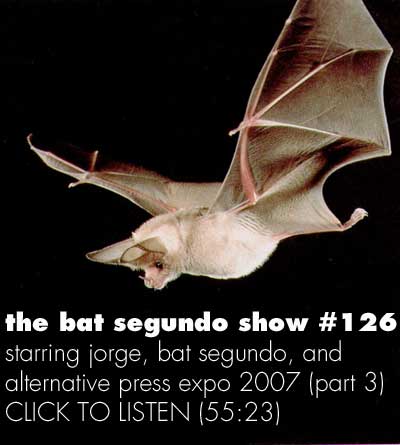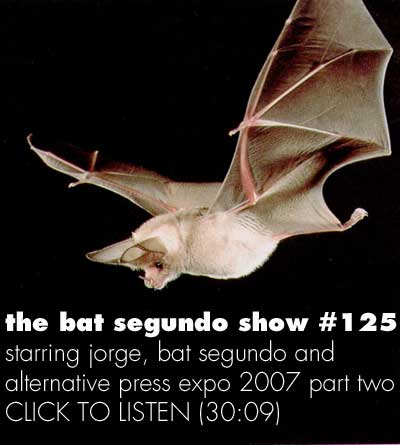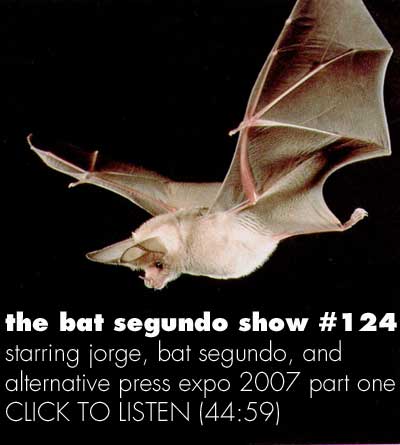Since the month of December is typically a slow month for the publishing industry, and since the wintry weather is conductive for this sort of thing, and since I have received several enticing graphic novels over the past few months, in December, I plan to devote these pages to investigating many of these volumes — while also gradually releasing the fifteen (!) podcasts I have in my backlog. In addition, I’ll also be covering the New York Anime Festival in a few weeks. If you are a comics publisher who would like to have your titles considered, feel free to email me or send me titles to the Flatbush address.
Category / Comics
Winsor McCay
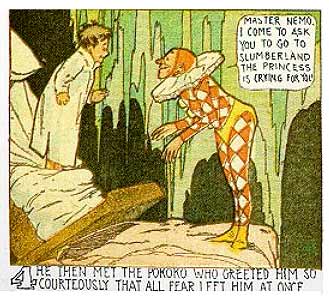 I will have more to say at length about Winsor McCay and, specifically, Checker Publishing’s reissue of The Dream of the Rarebit Fiend later. For now, I direct you to Josh Glenn’s slideshow, depicting McCay’s influence upon other filmmakers, and this website for the book. And I must also direct you to this interesting tale concerning “Gertie the Dinosaur.” The story goes that, sometime around 1913, another newspaper cartoonist bet McCay that he could not bring a dinosaur to life. McCay then came up with this groundbreaking animation in 1914 (YouTube). Note the attention to detail in the movement and the very fluid detail in the way that Gertie investigates the elephant. There is also Derik’s tribute to McCay from last year, in which he examines McCay’s use of page layout and sequence in relation to Little Nemo in Slumberland. There is also this explanation from Ulrich Merkl, which explains precisely how The Dream of the Rabbit Fiend was restored for publication. There is also this odd audio dramatization, which attempts to render McCay’s universe into oral form. There is also lost McCay art found not long ago, with stunning colors and efforts at restoration. There is also McCay’s response to Clair Briggs’ 1926 questionnaire. If you are fortunate enough to be in Ohio, there is this McCay exhibit for your edification. There is also a DVD available of McCay’s animation.
I will have more to say at length about Winsor McCay and, specifically, Checker Publishing’s reissue of The Dream of the Rarebit Fiend later. For now, I direct you to Josh Glenn’s slideshow, depicting McCay’s influence upon other filmmakers, and this website for the book. And I must also direct you to this interesting tale concerning “Gertie the Dinosaur.” The story goes that, sometime around 1913, another newspaper cartoonist bet McCay that he could not bring a dinosaur to life. McCay then came up with this groundbreaking animation in 1914 (YouTube). Note the attention to detail in the movement and the very fluid detail in the way that Gertie investigates the elephant. There is also Derik’s tribute to McCay from last year, in which he examines McCay’s use of page layout and sequence in relation to Little Nemo in Slumberland. There is also this explanation from Ulrich Merkl, which explains precisely how The Dream of the Rabbit Fiend was restored for publication. There is also this odd audio dramatization, which attempts to render McCay’s universe into oral form. There is also lost McCay art found not long ago, with stunning colors and efforts at restoration. There is also McCay’s response to Clair Briggs’ 1926 questionnaire. If you are fortunate enough to be in Ohio, there is this McCay exhibit for your edification. There is also a DVD available of McCay’s animation.
The upshot is that if you have not heard of Winsor McCay, it would behoove you to check him out immediately.
How a Mosquito Operates (1912)
Comic Book Icons to Appear on “The Simpsons”
I’ve just learned from Eric Reynolds that Daniel Clowes, Art Spiegelman, and Alan Moore will appear on the October 7 episode of The Simpsons. Sayeth Reynolds:
The plot concerns Comic Book Guy, who gets some competition in Springfield from a new store, “Coolsville Comics & Toys,” run by “hipster” Milo, voiced by Jack Black.
No word yet on whether either of these folks will appear with a bag on his head.
Personally, I’m Waiting for R. Crumb to Meet Michael Mollan
Berkeley Breathed Returns to Rabble-Rousing?
Editor & Publisher: “At least 25 of the 200 or so “Opus” client newspapers might not run the Sunday-only comic’s next two episodes, which feature Islamic references and a sex joke.”
One of the very funny strips in question can be found here.
BSS #126: Alternative Press Expo 2007, Part Three
[This is the last of the three APE 2007 podcasts. All three podcasts will eventually be available on the main Segundo page. But for the moment, here are temporary links to Part One and Part Two]
CONDITION OF MR. SEGUNDO: Searching for surgical uses involving his tequila bottle.
GUESTS: Helen Parson, Ruben Fernandez, Bud Burgy, Mike Hampton, Suzanne Kleid, Shannon O’Leary, Jennifer Joseph, Brian Colma, an unqualified “lowly human,” various representatives of Kaiju Big Battel, John Schuler and William Binderup, Jose Lopez, Liz Baillie, Bob Self, Richard Ruane and Tim Trosky, Mikhaela Reid, Stephanie McMillan, Matt Bors, Masheka Wood, Robert Steven Rhine and Hollie Stevens, Corwin Gibson, Matt Bernier, Mel Smith and Steve Oliff
SUBJECTS DISCUSSED: The nutritional qualities of flavored ghosts, the trouble with comic book names, telemarketing poets, penny aphorisms, a search for a mean-spirited fan who may live in Wisconsin, marital modeling and zombies, a comparative discussion between zombies and corpses, pet noir anthologies, conducting poetry discussion at a comic book convention, how to make cartoons more respectable, using aggression for control of the universe, how to exploit and make money out of kaiju monsters, getting people hooked on poop jokes, conflict that attracts people, character design for Batman and Teenage Mutant Ninja Turtles, working on secret projects for Google, how to riff on the sacrosanct world of Degrassi High, Gris Grimly, a pair of books by a pair of sisters, shy guys, moms and drugs, the distinct lack of attitude within Cartoonists with Attitude, love and anger, on having sharp opinions without being angry, the Reese’s peanut butter cup concoction of girls and corpses, clown porn and Mensa, unexpected enthusiasms for the Orange County Sheriff, Nacho Libre vs. luche libre, Jack Black, trying to eat a hot dog and selling comics at the same time, excluding the important sexual elements of a classic myth, how Bob Burden is giving the Gumby crew ulcers, on Mel Smith being the Henry Kissinger of Gumby, and Paul Reubens and Gumby.
EXCERPT FROM SHOW:
Correspondent: You seem very pleasant for someone who has attitude.
Reid: We all!
Correspondent: And someone else speaks for you here.
Bors: Nah, I’m pleasant in person. I don’t know. Uh I’m just chilling at a convention.
Reid: His strip is called Slut of Guantanamo Bay. He’s not that pleasant!
Correspondent: But he’s very pleasant about it right here.
BSS #125: Alternative Press Expo 2007, Part Two
CONDITION OF MR. SEGUNDO: Longing for phone numbers and fistfights.
GUESTS: Julia Wertz, Julie Walker, Levni R. Yilmaz, Bill Morse, Neil Fitzpatrick, Brandon Bird, Ming Doyle, John Rivera, Steve Fuson, Zack Corzine, Christopher Perguidi and Keith Knight
SUBJECTS DISCUSSED: Comics inspired from Craig’s List Missed Connections, unusual underwear, tactile animation, web comics vs. minicomics, an update on the Neil Jam universe, the practice of appropriating every known cultural construct, mullets, a comic book adaptation of a rock opera, family-friendly gnomes, using all five senses to experience a narrative, cannibal cooks, standing out among zombie comics, meticulously placed exclamation marks within comic book titles, grammar and comics, and how to work on comics in Los Angeles.
EXCERPT FROM SHOW:
Correspondent: So I was passing by a booth and I found some very unusual underwear designed by someone here. Maybe you can identify yourself and explain what the purpose of this underwear is, why it exists, and why it is being offered to the public at large.
Walker: Um, my name is Julie Walker and I really wanted to put weenies onto underwear. Because it seemed like a good idea.
BSS #124: Alternative Press Expo 2007, Part One
[This is the first in a series of podcasts devoted to Alternative Press Expo 2007.]
GUESTS: Carmen Ogden, Heather Morgan, Jess from CW, Sacha Arnold, Stephen Notley, Sarah Weinman, Jacquelyn Mentz, Tammy Stellanova and booth babe, Gabriel Martinez, Brian Andersen and Preston (cheerleader), Alex Cahill and Jad Ziade the laconic writer, Bryan Lee O’Malley, Tessa Brunton, Melina Mena, DJ Bryant, Travis Fox, two guys talking about waffles, Argel Brown and Michael Galande, Hope & Nicolette Davenport, Jeff Zugale, and Kristian Horn.
SUBJECTS DISCUSSED: The glut of autobiographical comics, Fat Camille, an unexpected skirmish between old media and new media, consulting cartoonists for tax advice, writing age-appropriate comics, handmade books, compartmentalized paneling, urban wildlife, the pigeon ecosystem, satanic raccoons, copraphilia, inverted superheroes, laconic comic book writers, whether or not robots are the savior of humanity, country bands and domain squatting, life’s rich pageant, retail humiliation, ripping off George Harrison, efforts to exploit the comic book circus atmosphere, waffles and freedom fries, turning interviews into comics, how to get rid of excess self-published comics, and superhero political comics.
EXCERPT FROM SHOW:
Correspondent: Whoa, whoa, WB and UPN have merged?
Jess: Yeah. About…
Correspondent: No one told me this!
Jess: I’m sorry. I mean, I’m hear to say. The last one to know. About nine months ago. But, um, it has shows like America’s Top Model and Simpsons and South Park.
Correspondent: But if WB and UPN merged, shouldn’t it be called WPN? Or UB?
Jess: Uh, that’s —
Correspondent: I mean, how the hell did you get CW out of it?
Jess: That’s a very valid…uh…what is this for?
Putting the Mash Into Mash Ups
Free Book Day
PW‘s Douglas Wolk reports on some of the successful efforts to turn average Joes and Janes into successful comic book regulars. Among one of the comic industry’s more enriching promotional tools is Free Comic Book Day, which disseminates samples and various issues of comics every year in May.
All this makes me wonder why the publishing industry isn’t working with bookstores to institute “Free Book Day.” With all the “sky is falling” hyperbole being tossed around by book critics and booksellers alike, would not disseminating literature on a specific day of the year be an apposite way to hook the next generation on reading?
In fact, if the high cost of printing a fat volume is a consideration, this might be a very good way of getting short stories and novellas into the public consciousness. If the publishing industry doesn’t want to take this up, then perhaps literary journals might want to coordinate with independent bookstores to remind the public that there are all sorts of fantastic stories to be read. And if not bookstores, why not publicize a Free Book Day where literary journals are handed out at subway stations or other places where people face the prospect of staring into space for 45 minutes or getting lost in a narrative?
This may seem a rather extraordinary solution, but this kind of pro-active approach sure beats throwing one’s hands up in the air and shrieking “The End is Nigh!” at the top of one’s lungs. And besides, wouldn’t it be a more interesting world — just for one day — if something like A Public Space or The Threepenny Review replaced The New York Sun as the free handout of choice?
I Get the Picture: Rachel Cooke is Living Under a Rock
I used to think that Rachel Cooke’s columns were authored by some sheltered journalist who never left her house and who simply wasn’t paying much attention to rudimentary trends developing in the publishing industry. Here, after all, was an idiot, who was actually collecting a regular paycheck for her foolish generalizations, castigating the litblogosphere based on one day of indolent Web surfing. Maybe she simply didn’t have the smarts to engage with the world around her. Maybe she preferred to furtively pick her nose and watch bad movies instead of doing a bit of thinking or even hard investigation of a genre.
But now, Ms. Cooke declares she’s seen the light! She’s one of us now! These things called graphic novels actually have literary merit! Never mind that Art Spiegelman won a Pulitzer in 1992 — a good fifteen years ago — and Maus‘s two volumes were nominated for the National Book Critics Circle. Ms. Cooke dutifully read Art Spiegelman and she could clearly see “how brilliant it was, of course.” But being cast of an utterly lazy and incurious mental disposition, Ms. Cooke, perhaps incapable of tracking down Will Eisner or Alan Moore or any of the countless graphic novelists working around the time, privately declared in 1986 that the landscape to be devoid of any additional talent. The “strips” that Ms. Cooke identified — as opposed to comic books or graphic novels, which every other neophyte was jumping up and down over; presumably, Ms. Cooke was confused and didn’t have a clue as to where to look — were giving her a headache.
But now no more! For comics are now mainstream! And this means that Ms. Cooke can rethink her prejudices against this retrograde medium because, well, these books are now too omnipresent to discount.
I’m very glad that Ms. Cooke has written this column. It is now entirely clear that she lives underneath a rock.
(Thanks to Andrew for the link.)
Are Harvey Pekar’s Recent Volumes Too Peripheral?
David Ulin raises a provocative point about Harvey Pekar’s recent prolificity, contemplating whether Pekar is authoring too many books for his own good, while likewise pondering whether Pekar’s concentration upon other personalities comes at the expense of Pekar skillfully depicting his own personal experiences.
While there exists plenty of evidence to confirm Ulin’s point about Pekar writing “work for hire” (Pekar intimated this during a 2006 appearance on The Bat Segundo Show), I don’t think these circumstances translate into an automatic critical condemnation of Pekar’s material. Ulin not only ignored 2005’s The Quitter, an inarguably raw and mature portrait of a younger Pekar developing some of his anger while being tormented on the Cleveland streets, but he failed to cite specifics about why he feels Ego & Hubris and Macedonia are lesser works. Ulin may very well prefer Pekar to his peripheral subjects. But if this is the case, why not simply state this?
I haven’t read Macedonia yet. But in Ego & Hubris, Michael Malice’s story (as conveyed through Pekar) struck me as a narrative uncannily similar to a Pekar-centric American Splendor issue: the case of a misunderstood and sometimes unpleasant misfit struggling against idiotic thinking and the everyday shackles of conformist instincts. Malice may not be as charismatic a figure as Pekar, but Ego & Hubris‘s deliberately boxy framings (as convincingly inked by Gary Dumm) and Malice’s obdurate Ayn Rand-influenced dialogue collectively serve up a new spin on the Pekar maxim: “Ordinary life is pretty complex stuff.” Malice — indeed “a piece of work” — may be a less ordinary figure than Pekar, but his struggles are just as complex as Pekar’s, if only because Malice’s “ordinary life” collides against the demands of paranoid security protocol, working at VH1, and his own self-serving instincts. It’s all pretty complex stuff, if you closely examine the many points at which contrarian philosophies run against each other.
Coming Up for Air
Thought I’d take a moment just to introduce myself after yesterday’s dive into the world of blogging. I have a novel coming out in September titled When One Man Dies. I’ve written several short stories over the years, which are available at my website.
Right now, reading wise I’m into comic books. I don’t know where that came from, but it’s probably a combination of things. Seeing Spider-man 3–which I actually liked–and reading a really, really fast paced novel by Duane Swierczynski called SEVERANCE PAKCAGE. It’s one of my favorite books and it comes out in the fall too.
Anyway, the book was so high paced that everything I read after wasn’t fast enough for me. So I figured I’d try some highly recommended comic books. And boom, now I’m back into trade paperbacks and graphic novels, and especially digging Ed Brubaker.
I Always Wondered What Betty Rubble Could Do With a Tuna Melt
Heidi McDonald reports on this extremely important contest: America’s Top Toon-a-MILF.
APE 2007 Photos
There’s a good deal of audio and comics that I’m still processing from Saturday’s insane immersion into Alternative Press Expo. But for the moment, here are some photos to whet your appetite.
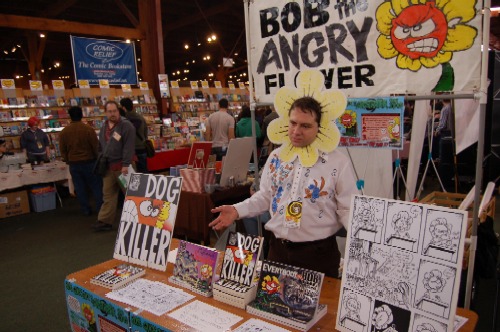
Bob the Angry Flower‘s Stephen Notley, located as per the APE custom next to Keith Knight, was solicited for tax advice and informed me of how one could write off a flower hat.
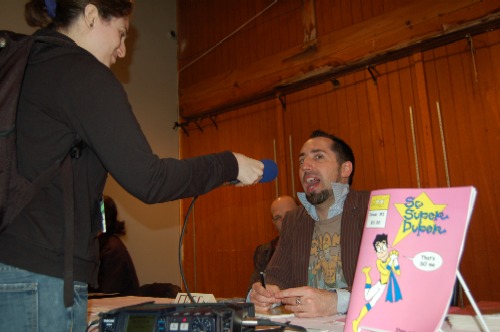
So Super Duper‘s Brian Andersen, as interviewed by one of the three Segundo correspondents employed for APE coverage (in one case, a correspondent smart enough to know the difference between Jeffrey Brown and Chester Brown was employed against his will).

There were many guitarists providing musical support for fellow artists in the booths.
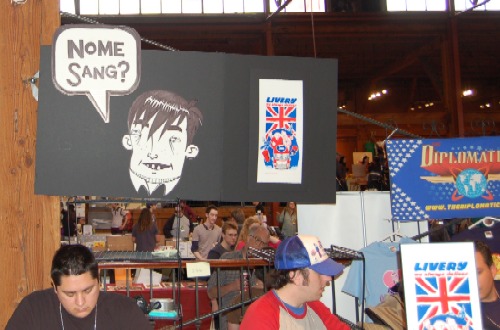
Nome Sang? It’s a question that I’ve asked myself many times: a query that offers no immediate answer. This sounds like a job for The Diplomatics, the world’s (only?) political superhero web comic.
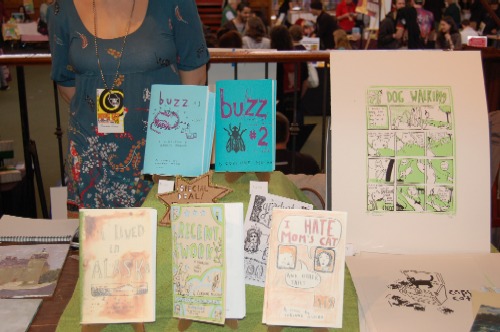
One of the aspects of APE often unremarked upon is the meticulous binding and sewing some exhibitors apply to their minicomics and illustrated chapbooks. Corrine Mucha was no exception.
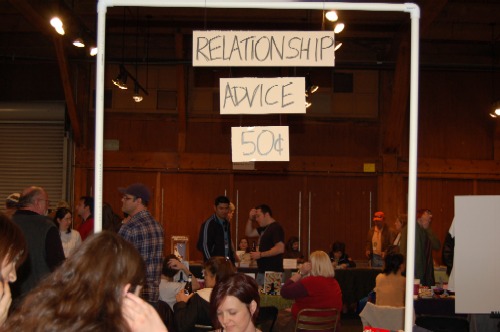
One did not necessarily need to pay two quarters for relationship advice, since there were many clear human examples through the transparent booth!
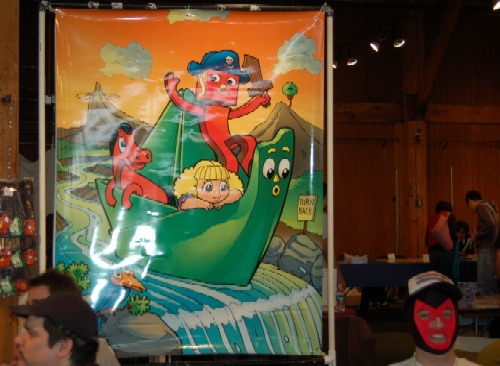
The man in the mask is, as you might gather, from Luchadork Comics. He was asked about whether Jack Black’s Nacho Libre or Luchadork came first and was unfazed by the Gumby propaganda.
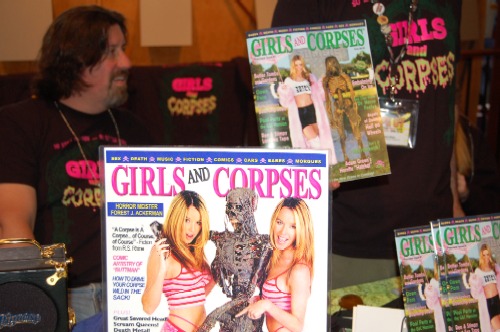
Girls and Corpses was easily the sleaziest magazine I picked up. I had thought that it was a one-off grand parody of Maxim, but there are apparently fifteen issues of this alarmingly slick publication. I talked with Robert Steven Rhine, the delightfully sleazy gentleman behind this periodical, and he insisted he lived on an estate comparable to the Playboy Mansion.

Pop cultural mimesis was very much on display, with an alarming number of items devoted to Christopher Walken. These items were from Brandon Bird‘s table.
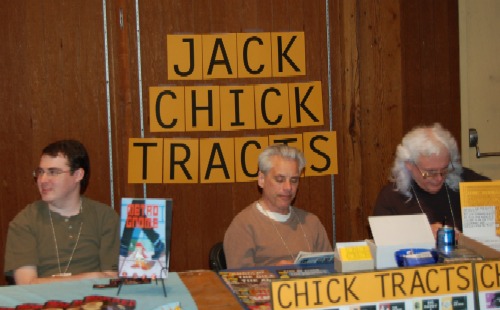
Despite noble efforts to track down the fundamentalist cartoonist Jack Chick, he was nowhere to be found at APE.
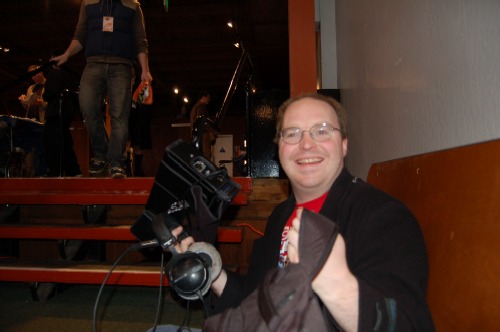
A rare moment when I was sitting down. There are about fifty audio files from Saturday I have to go through.
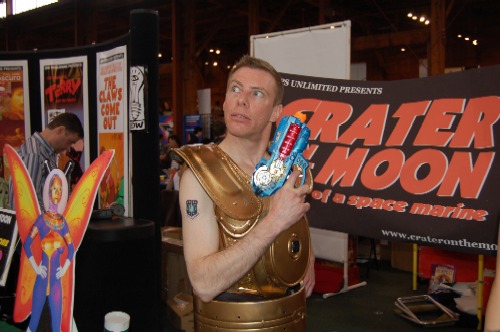
This gentleman, from Crater on the Moon, was apparently influenced by the Marvin Martian sartorial school.
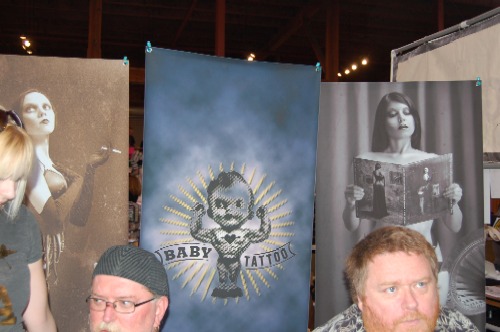
Baby Tattoo Books, the publishing house devoted to publishing Gus Grimly’s narratives.
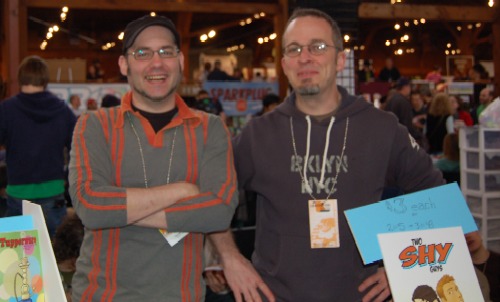
Two Shy Guys — or at least one of the men behind this comic. The gentleman on the left is currently being sought by G-men for certain indiscretions uttered on audio.
[UPDATE: Pink Raygun has an incredible breakdown of all APE exhibitors.]
[UPDATE 2: More APE writeups from Great White Shark, which rightly points out that APE is the only convention with a fully-stocked cash bar, Scott Beale, Spectoria, APE Bingo from Shannon Garrity, Superheroes Don’t Wear Sneakers, Tom Geller, Sip Tea, Moose River and Artnoose.]
Johnny Hart, 1931-2007
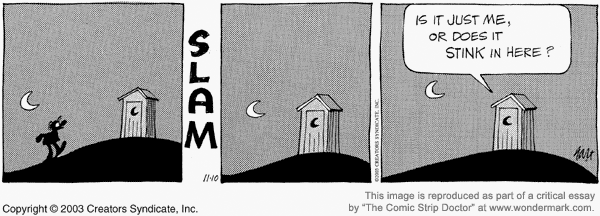
Jewish Journal: “In the days leading up to its publication, the Easter Sunday strip, which featured quotations from the New Testament juxtaposed against images of a burning, seven-branched menorah that transforms into a crucifix, became the object of concern among Jewish watchdog agencies. The 71-year-old Hart has written and drawn ‘B.C.’ since 1958, which appears in roughly 1,300 newspapers, reaching millions of families around the world. Hart, a devout Christian, has increasingly presented strips with explicit religious overtones.”
Of Course, Bil Keane Would Take That as a Compliment
John Brownlee: “You know, I remember when I thought New Yorker cartoons were cutting-edge stuff, clever and bold. Now it’s like Family Circus for smug metropolitan pseudo-intellectuals. Sometimes I wonder if it wasn’t always like that, though.”
Forensic Science
Adam Rogers: “To me, Cap is supposed to be chasing the American dream, and fighting whoever’s keeping it from happening. Some days that’ll be the government, some days it’ll be the Red Skull. Would Cap be fighting in Iraq right now? Probably—but he’d be over there uncovering the malfeasance that got us there in the first place, too. So here’s my question: If the government does something that smells a little fascist, a little un-American, and Captain America stands up and says, nope, this is wrong, won’t do it. Wouldn’t most people…um…believe him?”
At Long Last, Someone Clarifies the Quality of Jim Davis’s Humor
STEPHEN HAS RELEASED THE PRINCE’S COCK, HALF AWAKE HERE; HALF ERECT
I didn’t know that Eddie Campbell had a blog until I read about it on Bookslut. One standout entry: comparisons between Campbell’s art and Alan Moore’s script from From Hell. And, yes, Moore’s a detail man, even when it comes to fellatio. One can only imagine how the script for Lost Girls looked like.
Second Wind for Lost?
Brian K. Vaughan, the comic book writer behind the excellent Y: The Last Man, has been hired as Executive Story Editor for Lost.
How to Make Bil Keane Not Suck As Much
RIP Dave Cockrum
Sad news from Peter David. Comic books legend Dave Cockrum has passed away. More info on Cockrum’s contributions can be found here.
No, The Term That Applies Here is “Pussies”
Editor & Publisher: “United Media sent an advisory to ‘Pearls Before Swine’ clients warning them that ‘language some readers may find inappropriate’ will appear in Stephan Pastis’ Dec. 2 strip. The term used is ‘bite me.'”
EC Comics
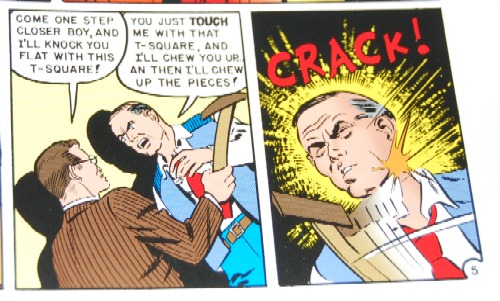
To my great surprise, Gemstone Publishing sent me two volumes of their EC Archives reprint series.
First off, a few words about EC Comics: I came of age decades after their inception and, as a great fan of William Gaines’ work on MAD, I was very curious about them as a young lad. Much like video games and industrial music were the MacGuffins for Eric Harris and Dylan Klebold’s murderous rampage in Littleton, EC Comics, thanks in part to persnickety psychologists, had been declared the cause of juvenile delinquency, leaving Gaines to find creative ways to bypass the Comics Code Authority’s often draconian demands.
I spent many years trying to track these mythical comics down and, at first, had very little success. But I did manage to track down a few reprints, inexplicably available at my public library, and began to see why Stephen King was inspired by them for Creepshow. The stories were unapologetically lurid, punchy, and featured all manner of colorful violence. They were often absurd, but they certainly grabbed your attention.
Years later, now that I have a more trained narrative eye, the stories are no less ridiculous; perhaps they are even more so. In the first story contained within Weird Science, Volume 1, a scientist is accidentally sprayed by an atomizer and begins to shrink in size. But this is no mere Richard Matheson ripoff. Each atom is actually a world, which in turn is composed of atoms, and, as the scientist continues to shrink, he encounters all manner of new civilizations. That all this is contained within an eight page story is fascinating enough. And it’s safe to say that this premise is hardly scientific. But in playing fast and loose with the rules of reality and keeping the pace swift, there’s still something oddly compelling about the scientist’s plight.
Of course, women regrettably come second in the EC Comics universe. I find myself troubled that they are reduced to being mere providers, often serving as trophies that men display to other men. (“Beautiful wife” is a recurrent appellation.) There is, in addition, a tendency for older men to call their younger apprentices “boy,” leaving me to ponder hypothetical homoerotic undercurrents.
At the same time, where else are you going to find such crazy dialogue like “Come one step closer boy, and I’ll knock you flat with this T-square?” or a monster remarking to surprised humans, “You see, I’m quite friendly! Come here!”
More than twenty years after I experienced EC Comics for the first time, Gemstone offers another chance to experience the strangely entertaining parameters of the EC Comics universe. I’m struck by the attention to unusually tight panels for dramatic emphasis and the eye-popping characters. (It is almost as if every character has their pupils permanently dilated.) But even with often bizarre and unjustified premises (such as a house that inexplicably shifts at various points in time without explanation), you have to admire EC’s narrative audacity, even if it remains permanently rooted in a decidedly 1950s style of subversiveness. And there’s the added bonus of seeing how such artists as Harvey Kurtzman and Al Feldstein fared when they weren’t inking satirical stuff for MAD.
Spidey 3 Trailer
Tony Long: Chickenhead of the Month
I’m a little late on this, but I think it can be said with almost complete certainty that Tony Long is a moron. It’s bad enough that Long has diminished local illustrator Gene Leun Yang’s accomplishments by claiming that his book American Born Chinese should be ineligible for the National Book Award because it is composed of pictures, but Tony Long, a superlative skybald content to toss around his uninformed opinions the way culinary naïfs want to take you to Domino’s for “really good pizza,” hasn’t even read the book in question. Like a hayseed fundamentalist who will always be right, even when having nothing more than a cursory understanding of what he’s talking about, Long is content to remark upon a work that he hasn’t even bothered to crack open.
Long claims that his essay is “not about denigrating the comic book, or graphic novel” and then proceeds to belittle Yang’s work by declaring, “I’ll bet for what it is, it’s pretty good,” as if “what it is” is not only as different as “apples and oranges,” but somehow lesser.
In bashing the book, Long notes that he is “familiar with the genre,” as if this generalized pronouncement of casual expertise, presumably originating from the deity now occupying Long’s head, justifies his capacity to remark upon a book that he is ignorant about by his own admission. Well, I’m “familiar” with the work of April Flowers, but I’m not going to comment upon WMB: Weapons of Masturbation until I’ve seen the film.
For a guy who seems to be “familiar” with comic books, Long can’t even get his terminology right. Like a milliner trying to sell you an asshat, Long refers to Yang’s work falls into interchangeably as “graphic novels,” “illustrated stories,” “comic books,” when these are entirely different forms. A graphic novel, for example, may be a collection of previously published comic books. You can call many children’s books or even some postmodern literary experiments “illustrated stories.” But if graphic novels “don’t belong” even in a juvenile literature class, then how are we to categorize the quest for meaning contained within Alison Bechdel’s Fun Home or the shifting perceptions of lust within Alan Moore and Melinda Gebbie’s Lost Girls? Surely, these are books. These works, among many, chronicle the human condition. They are laced with plots, characters, narratives, subtext, and visual and verbal language just as intricate in their creation and execution as blueblood word-centric novels. And yet we continue to throw them in a separate section in the bookstore and deny these books their credentials, imputing by taxonomy that they will never drink from the whites only drinking fountain occupied by FICTION.
The Tony Longs of the universe, who regale us with their callow and deliberately ignorant banter, will continue to offer the hard line that these are lesser works without proof. They will continue to comment upon subjects without studying what they purportedly examine or providing us with specific examples. It’s sadly telling that a publication like Wired, which reports on advances technology and is thus progressive in some sense, would employ an atavistic microbe to mold up the boss stone.
Public Perception
Berkeley Breathed nails it. (Thanks Suzanne!)
And If He Woke Up a Few More Years Later, He’d Be Detained at Guantanamo Bay
The incomparable Professor Fury has a fantastic post on a particularly interesting Captain America storyline. Captain America said some particularly compelling stuff, worth keeping in mind for tomorrow’s elections.
